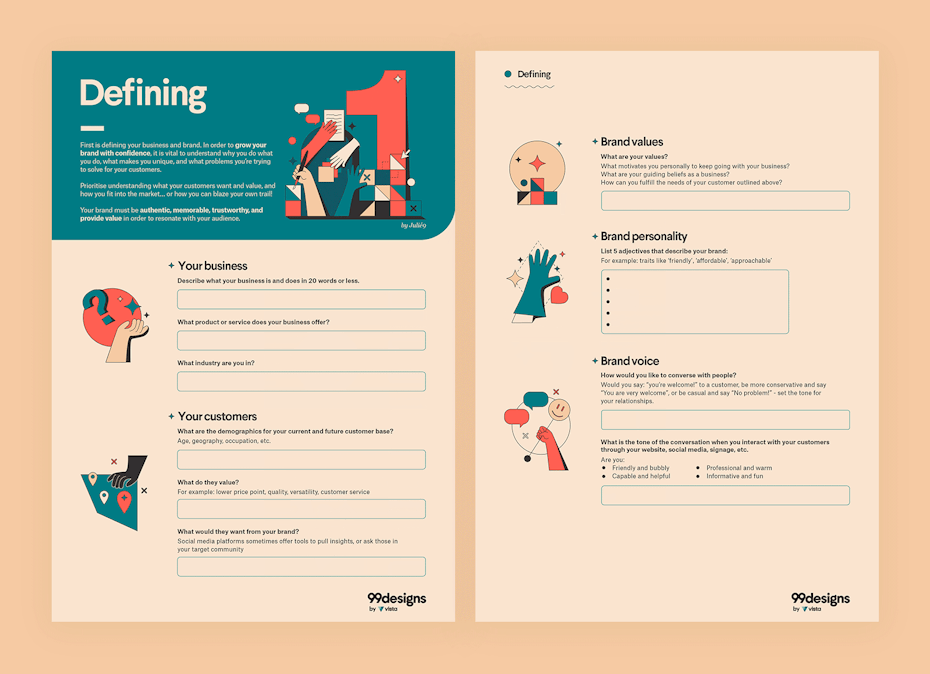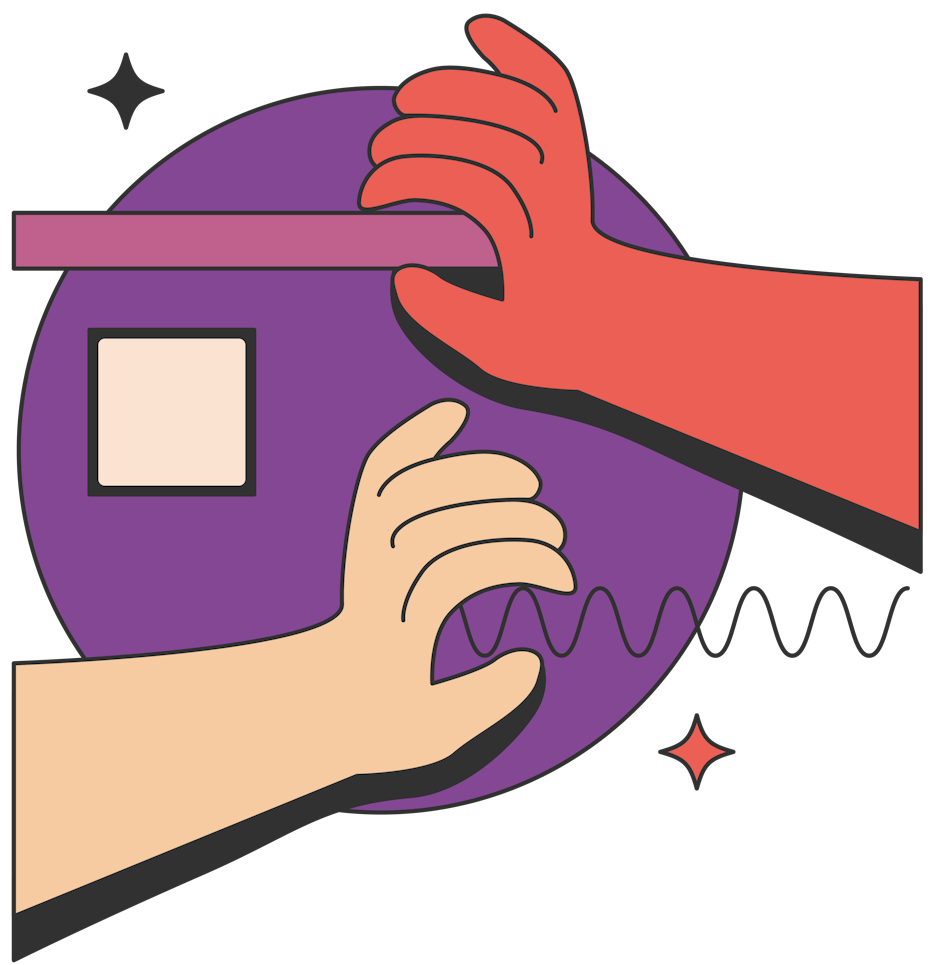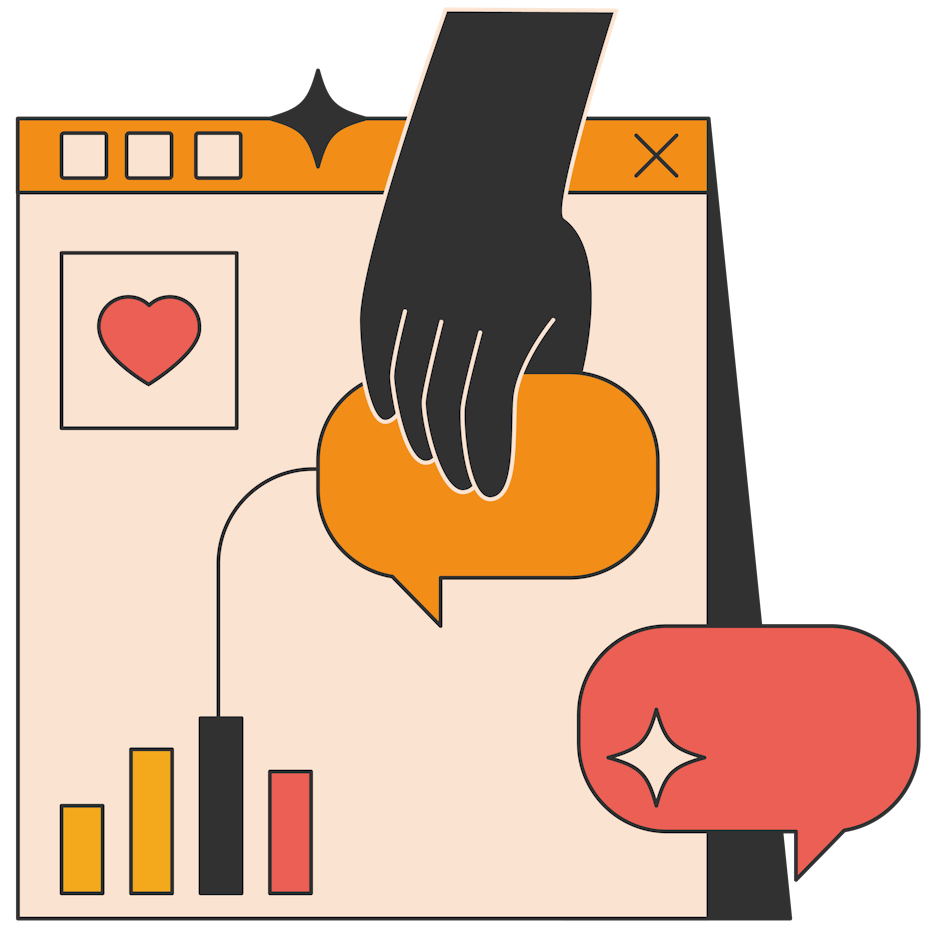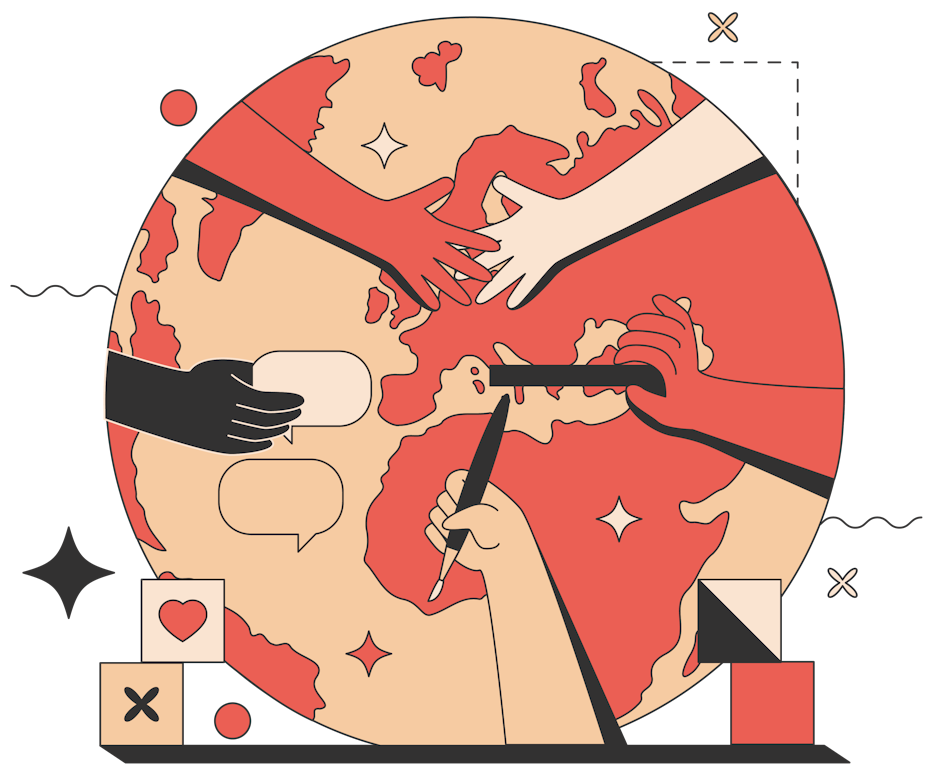A branding and marketing strategy is essential to the success of a small business. This is the framework by which you define who you are, differentiate yourself from your competitors, communicate these qualities through design and reach your target audience effectively. Because it is capable of so much, there are many moving parts that go into building a brand and marketing plan.
That’s where a brand strategy template comes in—a detailed worksheet can make this nebulous process painless and straightforward.

Whether your small business is preparing to launch or has been up and running for some time, it is never too late to assess your business plan. The following branding worksheet is designed to take you through each essential aspect of your brand and marketing strategy in order to develop a business summary. This summary will act as your guiding light throughout your marketing efforts, and it will provide practices that you can put into action right away.
Your guide to a small business marketing plan
—
Worksheet 1: defining
—
A brand begins with you. It is an encapsulation of your identity as a business, of everything that makes you unique—from the practical services you provide to the way you speak in daily interactions with customers. And the best brands come from a place of authenticity. To understand how to build a brand, begin by defining who you are.

Your business
Before we get to more intangible brand characteristics, let’s review the basics. What business are you in? How does it work? What product or service do you provide? What market industry does your business fit into?
Specificity is key here. Saying that you are in the home repair business is helpful, but specifying that you are locally-owned, specialize in plumbing and provide round-the-clock support from an accredited workforce is much more descriptive. Even if your business isn’t some innovative, industry-disruptor, you can still uncover traits of individuality at this early stage if you dig deep enough.
Your customers
Whom does your business serve? Consider both your current customers and those that you want to reach in the future. Together, these form a target audience, the people you are basing your entire small business marketing plan around.

There are a few useful ways to categorize your target audience. One is through demographic information, such as their average age range, location, income, educational background, employment, etc. While this data is relatively basic, it functions as a starting point. From there, you can dig deeper into who your customers are as people—their values, preferences and interests.
While every customer is a unique individual, your business strategy framework has to take into account several people at once. That is to say, you can’t avoid generalizing, and many businesses will sort their customers into archetypical categories. These can be personalized through personas, wherein you will put representative faces, names and characteristics to the various segments of your customer base. Doing so can make it easier to think about your customers both collectively and individually.
At the end of the day, having an accurate picture of customers means combining demographics and psychographics, so that you know where customers come from, what drives them and how they communicate. This will put your small business in a much better position to understand the problems it needs to solve for customers and to produce branding and marketing communications that will be relevant.

Brand values
Just like your customers, your brand should have values. This is the ‘why’ behind your business, the reason that you started your business in the first place. This is also what keeps you motivated to preserve day in and day out.
Hopefully it goes without saying that your brand values should be about more than making money. They should be related to what you bring to the community—not the other way around. For example, when Mochinut founder Rachel Aquino opened an Asian fusion donut shop, it was about more than offering a tasty treat. “When you have a chance to integrate a piece of your culture into mainstream food culture, there is so much power in that,” she told Logotype.ie by Vista.
Likewise, think back to the initial spark that you had when coming up with your business idea—you knew it would succeed because it served a purpose for people. Hone in on that purpose and translate it into a core brand value.
Brand personality
If your brand is your business’s identity, it has to have personality. Like a real person, brand personalities consist of a whole host of character traits, from bubbly and fun to cool and professional. The purpose of a brand personality is to foster an emotional connection—you can pitch your business ad nauseam, but people tend to make decisions based on unconscious factors rather than cold, hard facts. Personality is a huge unconscious factor that determines whether or not people will “get along” with your brand.

Developing a brand personality involves meeting customers’ exceptions. If your business is in finance, customers are likely to expect authority and professionalism because people want to know that they can trust you with their money. At the same time, all finance brands are probably going for these traits to some extent, and a true personality has to be unique and particular. To dig deeper, remember that personality comes from within. The more the brand personality is modeled on the people behind the business, the less forced it will come across. Finding the middle ground between yourself, your brand values and your customers’ expectations is the best way to stake out a memorable brand personality.
Brand voice
It’s not just what you say but how you say it, and that’s where brand voice comes in. A brand voice is the set of guidelines that dictate how you communicate, shaping your phrasing, vocabulary and formality. It informs the tone of everything from marketing materials to staff-customer interactions, which is why consistency in your brand voice is essential. Incongruity here can turn a brand into an embarrassment—consider these brands desperately chasing attention online.

Brand voice is strongly tied to brand personality, being one of the many manifestations of it. So that is where you begin: based on the personality traits you outlined in the previous section, what would that person sound like? How would they phrase common sayings like “Hello,” “Can I help you?” and “You’re welcome.” Consider the desired effect you want to have on the listener. Like a good speech, a brand voice can empower listeners to action. It can also soothe, educate or shock people. Merging the brand personality with this desired effect will lead you to a brand voice people actually want to hear.
Worksheet 2: differentiating
—
Your brand may begin with you, but that isn’t where it ends. Your small business has to fit into a market environment, where it will sink or swim alongside other small businesses. The key to standing out against the completion is to differentiate—to define your brand in contrast to other, similar brands. In this stage of our branding worksheet, you will make the case for what you have that other businesses don’t—even if there isn’t much surface difference between your products or services.
Competition
First, you’ll need to identify your top competitors. These are the brands that most closely resemble yours, with similar products, price points, identities and/or target audiences. And focus on top competitors: if the brands you choose are struggling or unsuccessful, that’s not going to be helpful to you at this stage. A true competitor is someone who offers you a real challenge.

Given these competitors have gone through a similar brand strategy process, your next step is to understand how that process has informed their business practices. Ask yourself, what makes their product special? What are the brand’s values? How do they communicate this to their target audience in advertising and social media? How would you describe their brand voice/personality? What does their visual aesthetic say about the brand? When evaluating these points, consider which aspects you personally like and which are done well (even if they are not to your taste). This will help you determine which factors your business might want to learn from and which, though effective, might not be the right fit for your brand.
Point of difference

Taking what you’ve learned from your top competitors, it is time to come up with your fundamental point of difference. Make sure you refer to your brand values and how you meet customers’ needs to see how you compare to your competitors. How do you want a potential customer to sum up what sets you apart from similar brands? Maybe you are more affordable, you can provide better customer service, you have the knowledge to impart, or you just have a great story behind your business that will resonate with people.
This will culminate in a value proposition—a succinct description of the full benefits you have to offer customers. Value is often determined by an equation, benefits minus cost. In other words, why is your business worth the economic risk to customers, especially when there are more established, trusted brands to choose from? It is important to note that you can have several value propositions—one for each of your products—but your small business marketing plan should outline an overarching value proposition for your brand as a whole.
Worksheet 3: designing
—
Design refers to your brand’s visual identity. While your brand may have values, a personality and a voice like a person, these are all intangible characteristics. Design is what allows customers to really see your brand, and it does so through visual cues like shapes, colors, lines, imagery and fonts. Individually, each of these fosters an emotional impression, but they must also work in harmony toward a cohesive aesthetic that fits your brand.
Design elements
Design elements are the building blocks of imagery, and they consist of lines and shapes. Although it is rare that you will use these basic elements in isolation, their simplicity makes them a great starting place for thinking about your visual aesthetic—that is, whether a style like minimalist, cartoonish, grungy or vintage will best express your brand.

You may wonder: what can a straight line say about my brand? Quite a lot! A thin line implies lightness and delicacy whereas a weighted line implies seriousness and strength. Similarly vertical lines can appear tall and commanding whereas horizontal lines can appear stable and calming. These simple line qualities can be translated into the outlines of shapes or the strokes of fonts.
Shapes also speak their own design language, even at their most foundational level. Squares convey security and consistency, circles convey joy and softness, and triangles convey danger and movement. Shape language can be translated from simple to compound forms, such as the silhouette of your logo, the compositions of brand photography, and even the alignment of text on marketing materials. To get started, consider which of these qualities match your brand and make a list of the corresponding design elements within the marketing strategy template.
Logo
A logo is a singular iconographic representation of your brand. It is sometimes literally called a brand mark after the way it can resemble a royal seal of approval. But its true purpose is to act as the face of the business, the most recognizable visual identity element that customers will associate with your brand.
Though there are many different types of logos, the most common will consist of a unique icon and the brand name. Whatever type you choose, an effective logo design comes down to a number of principles: it has to be clear, versatile, timeless, memorable and original.

Because a logo will be used in a variety of contexts, some of which you won’t be able to predict, it has to remain legible no matter this size and background. This is why many logo designers favor simplicity, as there are less factors that can go wrong when the logo is adapted. Simplicity also fosters memorability and timelessness—visual noise gives people too much to remember at once and overly decorative elements tend to become dated as fashions change. But the best way to create a memorable logo is through originality.
Just as the brand is defined and differentiated from its competitors, the logo should have its own sense of identity. There are two factors that can come into play here: symbolism and visual style. Symbolism refers to using a logo, icon or imagery to represent meaning or ideas. This can be a well known symbol or it can be something personal to your business.
Visual style is another way to set your logo apart, whether it is illustrative, abstract, geometric or organic. Style takes its cue from brand qualities—a hand-drawn logo will come across as approachable and casual while a geometric style can seem sleek and modern. Along these lines, list out some adjectives that can translate to a visual style that suits your brand: such as classic, mature, luxurious and sophisticated.
Colors
Color is one of the most powerful tools for controlling the entire mood of a composition. A brand color scheme will be used for all branding materials, from advertisements to website colors to employee uniforms.

Typically, a brand will choose a dominant color, secondary color, and an accent color. More colors than this tend to sacrifice brand coherence. Color theory provides a number of useful schemes, such as analogous, triadic and complementary, for choosing colors through the science of the color wheel.
But the most important factor in choosing the right scheme for a brand is color psychology. Each color is capable of inducing a specific emotion, such as red signaling passion, yellow signaling joy and blue signaling maturity. These associations will vary by culture, so it is important to localize your color scheme to your target audience.
Not only do colors come in different primary hues, but they can also be further augmented through saturation and brightness. This will have an effect on their emotional impression, sometimes dramatically so. For example, green is commonly associated with nature and wellness, but high-saturated green can look like toxic sludge.
Fonts
Fonts, or typography, refer to the styling of the letters. A brand will typically choose a logo font (though this is frequently custom), and from there will develop congruent fonts for headline and body copy. There are a few basic types of fonts to consider, each with its own cognitive associations based on their shape and historical usage.

- Serif: This font is recognizable for the small strokes attached to the ends of letterforms. Because it is associated with old-school printing, it conveys traditionalism and respectability.
- Sans-serif: This font is named after the fact that it does not have a serif. Because it grew to prominence in the digital age, it conveys modernity and simplicity.
- Script: This font is styled after cursive lettering. Because it is both decorative and thin, it conveys opulence and elegance.
- Display: This font is most commonly used for headlines. While it can be as simple as a large, bold typeface, most display fonts use their size for elaborate illustrative techniques. As the most eclectic font, the association it carries will depend on the particular style, but in general, display fonts come across as unique and playful.
Worksheet 4: marketing
—
With your brand identity established, all that is left is to share it with the world through marketing. Marketing is the process by which you communicate and deliver your brand offering to an audience. This is where you will test whether the brand strategy framework you have conceived is salient, whether it is perceived as you intend and whether it is helping or hindering your business. But while this stage does provide insight into your brand, marketing is ultimately about your customers.

Community
The first step in your small business marketing plan is to find your community. While similar to a target audience, your community describes people who really connect to your product, values and mission, to the point of becoming brand ambassadors. In other words, these are the people who will advocate for the brand to their friends and family. Identifying and fostering this community will allow you to build word-of-mouth marketing, which has been proven to be significantly more powerful than paid marketing.
A great place to start your search for community is social media. Who is following your account and interacting with your posts? This shows that they are motivated: the average person doesn’t digitally engage with every brand they consume. Even better, you can find a community in online spaces that you don’t control—forums like Reddit or review sites where people are already talking about your brand. And if you are a brick-and-mortar store, you can find community in your regular customers.

Another great way to find and build community is by partnering with people in your local neighborhood on campaigns. For example, streetwear brand Cukui worked with local community members to model their shirt designs for their “Stop Asian Hate” shirt design. This approach not only gets you more involved in your own backyard, but it also allows you to build your brand network through cross-promotion. However you go about it, make an effort to get to know these people, learn about their lives and where else they spend their time—in what spaces, both online and in-person, do they have their own communities?
Your business goals
At the end of the day, brand identity and community don’t mean much if you’re not going to do anything with them. Both of these factors have to relate back to your business goals.

A common marketing tool for constructing goals is the SMART method: goals must be specific, measurable, attainable, relevant and time-bound. Under this approach, consider goals that clearly define what exactly you want and which metrics will indicate success. Ideally, the goal should be something you can achieve—growing your small business to the size of a conglomerate like Amazon is probably out of scope—and you should be able to accomplish the goal within an isolated period of time.
Connecting these goals to your audience means communicating your value proposition in design and marketing. This can be formalized into a campaign, in which you can use assets such as posters/flyers, social media posts and email newsletters to give your audience a motivating reason to convert.
![illustration of a hand holding up a star]](https://99designs-blog.imgix.net/blog/wp-content/uploads/2022/12/Worksheet_4-4.png?auto=format&q=60&fit=max&w=930)
Adding Value
Besides your product, what are other ways that you can create value for your customers? Although we identified potential community members in a previous section, this stage is where these people truly become more than customers. That only happens when you have something to offer beyond a transactional relationship.
Additional value may be as simple as knowledge. For example, although Ritual By Design founder Sabreena Haque already had a thriving business in San Francisco, she created DIY henna instruction kits to pass the ancient tradition onto the next generation. Another way to add value is through content that your audience finds amusing, such as an entertaining social media feed that brightens their day. You might also consider getting involved in the local community, leveraging your resources and customer base to sponsor local events or charity campaigns. Although these efforts may not directly increase revenue, adding value is the best way to enhance your customers’ experience with your brand.
Download a free brand strategy template today
—
A branding and marketing strategy is an invaluable tool for growing your business. Your brand defines who you are and how you are different from the competition. Design dictates how you present yourself to your audience and marketing shapes your relationship with that audience. And a template for a marketing plan makes the entire process far less intimidating.

The beauty of a small business brand strategy is that it’s not something that you do just once. If you find that your brand is making the wrong impression or your marketing is not achieving results, you can go through this worksheet as many times as you need. With that said, ideally you should aim for incremental changes to your brand whenever possible as constant, drastic changes will make it hard for the audience to keep up. But even if you don’t have a specific qualm with your brand strategy framework, you can make going through this worksheet a periodic practice—if for no other reason than to refresh yourself on who you are and why you do what you do.
We've just sent you your business summary template.



